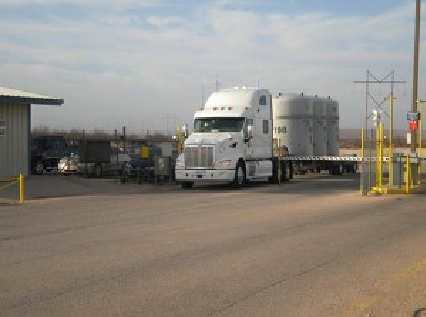As information continues to trickle out about the April accident at Waste Isolation Pilot Plant (WIPP) near Carlsbad, New Mexico, once again I am going to offer an update. WIPP has been open for fifteen years and is the only repository used to dispose of plutonium contaminated waste from the U.S. nuclear weapons program.
In April, a drum of waste exploded and released radioactive particles into the environment. Research has now suggested that hundreds of drums of waste from the Los Alamos National Laboratory (LANL) were packed with an absorbent that reacts with the nitrate salts in the waste to produce explosive substances. This danger was clearly stated in the packaging for the absorbent. There are emails from subcontractors at LANL asking someone from the lab consider the safety issues that might be associated with the new absorbent but it is not known whether anyone at the lab researched the dangers. In any case, the use of the new absorbent was approved.. The WIPP was closed by the accident and some of the dangerous drums of waste are also still at the LANL while at least a hundred more are in temporary storage in Texas.
When the WIPP was developed in the old salt mine, big open areas called Panels were divided into rooms which were filled with drums of waste. Originally when a Panel was filled with drums, a twelve foot thick explosion isolation wall was used to seal the Panel. Overtime, the Department of Energy reduced the safety requirements for WIPP and the Panels were sealed with a steel bulkhead that was not explosion proof. Eventually, even the steel bulkheads were abandoned.
When Panel Six was totally filled with drums of waste, it was not sealed off as previous Panels had been. The explosion that took place in Panel Seven could have contaminated the waste drums in Panel Six. The Secretary of the New Mexico Department of the Environment has demanded that both Panel Six and Panel Seven be immediately sealed with bulkheads that can withstand explosions in case more of the drums from LANL explode. To make matters worse, there was no detailed record of exactly which drums were stored where in a particular Panel. Electronic records had not been updated when new shipments of drums arrived. This lack of good records impeded the investigation into where the exploding drum had come from.
The LANL has not been forthcoming with answers and documents that involve the actions of the subcontractors, the decision to use that particular absorbent or what testing was done at LANL, if any. They still not confirming that the absorbent is the problem. Questions are being referred to the Department of Energy, the "customer" of LANL.
Prior to 2006, drums of waste bound for WIPP were routinely inspected to insure that the contents of the drums were accurately represented by the manifest that accompanied the shipment. In 2006, the New Mexico Environmental Department changed the rules for inspection so that testing was reduced to a few random drums. While these inspections would not necessarily have caught the drums with the bad absorbent, they do clearly illustrate that the rules for safe handling of waste at WIPP were weakened and even ignored as the years went by. This happened because there were no significant accidents for fifteen years. But it should never have happened. These wastes are very dangerous and they must be treated with respect or more such accidents are guaranteed.
Transuranic Waste Shipment:
